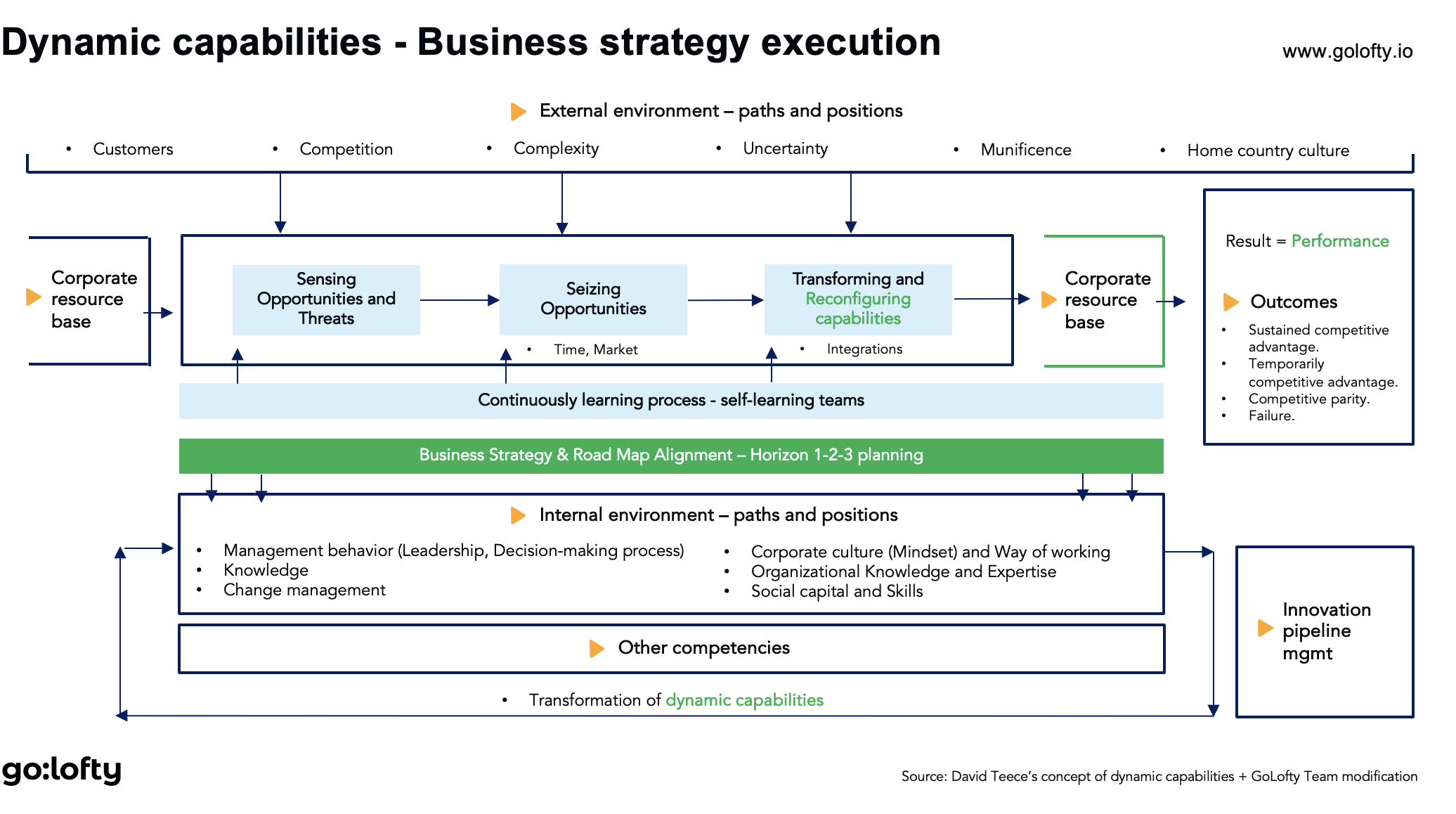
In the ever-evolving world of business, agility is no longer a competitive advantage—it’s a necessity. With technological disruptions, changing market dynamics, and shifting customer demands, organizations need to be prepared for constant transformation. This is where David Teece’s concept of dynamic capabilities becomes indispensable. As one of the most influential ideas in strategic management, dynamic capabilities focus on an organization’s ability to adapt, innovate, and reconfigure resources to meet the challenges of an unpredictable future.
But what exactly are dynamic capabilities, and why are they crucial in the context of strategic management? Let’s explore the key tenets of Teece’s framework and understand why it’s become such a pivotal concept for businesses today.
What Are Dynamic Capabilities?
First coined by David Teece, a professor at the University of California, Berkeley, the dynamic capabilities framework is a theory that seeks to explain how businesses can achieve sustainable competitive advantage in environments characterized by change. According to Teece, it is not enough for firms to possess valuable resources or static capabilities. Instead, businesses must have the ability to dynamically reconfigure their resources, capabilities, and competencies to innovate and respond effectively to evolving external conditions.
At the heart of dynamic capabilities are three fundamental processes:
Sensing Opportunities and Threats: This involves scanning the environment, identifying new market trends, technological disruptions, or customer needs. It’s about being attuned to shifts in the landscape that could either present new opportunities or pose significant risks.
Seizing Opportunities: Once an opportunity or threat is identified, companies must act quickly to capitalize on it. This often involves investments in new products, technologies, or business models that allow the company to stay ahead of competitors.
Transforming and Reconfiguring: To maintain long-term success, firms need to continually transform their organizational structures, processes, and assets. This could mean adjusting the company’s resource base, divesting from outdated capabilities, or acquiring new competencies that align with future growth opportunities.
In essence, dynamic capabilities emphasize the importance of continuous innovation, learning, and adaptability. It shifts the focus from simply holding a competitive position to building the agility needed to sustain it over time.
Why Dynamic Capabilities Matter in Strategic Management
Traditional strategic management models often emphasized long-term planning and achieving static competitive advantages. Companies would analyze their internal resources and external market conditions, then craft a strategy that allowed them to outcompete rivals by controlling key assets or achieving cost leadership. However, this approach is no longer sufficient in today’s rapidly changing business environment.
The dynamic capabilities framework provides a more realistic and flexible approach to strategic management, especially in industries driven by technological disruption, globalization, and digital transformation. Here’s why dynamic capabilities are so important:
1. Navigating Uncertainty
In the modern economy, the only constant is change. Whether it’s shifts in customer preferences, new regulatory landscapes, or emerging technologies, businesses must be prepared to navigate uncertainty. Dynamic capabilities allow organizations to stay nimble and continuously scan the environment for signals of change. This proactive approach helps businesses avoid being caught off guard by disruptive forces.
For instance, consider how companies in the retail sector have had to adapt to the rise of e-commerce and digital platforms. Businesses with strong dynamic capabilities, such as Amazon, have been able to sense these shifts early on, seize the opportunity by investing in digital infrastructure, and continually transform their business models to stay ahead.
2. Maintaining Competitive Advantage
In industries with rapid technological advancements, competitive advantages are often fleeting. What worked yesterday may not work tomorrow. By focusing on dynamic capabilities, companies are better positioned to sustain competitive advantage by constantly evolving. The ability to adapt faster than competitors becomes the key differentiator.
Apple, for example, continuously reinvents its product line and business model. From launching the iPod to revolutionizing the smartphone industry with the iPhone, and now focusing on services like the App Store and Apple Pay, Apple exemplifies how dynamic capabilities can drive sustained competitive advantage through constant innovation.
3. Resource Flexibility
The traditional view of resources as fixed assets that provide competitive advantage is being replaced by a more fluid understanding. Dynamic capabilities focus on how companies can reconfigure their resource base to meet new challenges. This might involve acquiring new technology, developing new skills in the workforce, or restructuring operations to become more efficient.
Tesla’s ability to pivot from being an electric vehicle manufacturer to a clean energy company with solar panels and battery storage solutions illustrates this concept. By dynamically reallocating resources and capabilities, Tesla has been able to broaden its market presence and continue innovating in new areas.
4. Driving Innovation
In a world where innovation is a prerequisite for success, dynamic capabilities provide the organizational framework for fostering it. Businesses that emphasize dynamic capabilities invest heavily in R&D, cultivate a culture of learning, and encourage experimentation. This focus on continuous innovation ensures that companies are not just reacting to changes in the market but actively shaping the future of their industries.
For example, pharmaceutical companies with strong dynamic capabilities have been able to develop groundbreaking treatments and vaccines by rapidly adapting to new scientific discoveries and regulatory environments. The ability to innovate under pressure is a hallmark of dynamic capabilities in action.
Dynamic Capabilities in Action: Real-World Examples
While many theoretical concepts in business struggle to find practical application, the dynamic capabilities framework has been widely embraced by successful companies across a variety of industries. Here are a few examples of dynamic capabilities in action:
Netflix: Originally a DVD rental company, Netflix sensed the shift to digital media early on. By seizing the opportunity to move into streaming and transforming its entire business model, Netflix disrupted the traditional television industry and has continued to innovate with original content and personalized recommendations.
Microsoft: Under the leadership of Satya Nadella, Microsoft shifted from a product-centric to a cloud-first strategy. The company sensed the growing demand for cloud computing, seized the opportunity through its Azure platform, and reconfigured its business to focus on subscription-based services like Office 365, ensuring long-term growth and relevance in the tech industry.
Procter & Gamble (P&G): Known for its innovation in consumer goods, P&G has developed strong dynamic capabilities by continually sensing consumer trends, seizing opportunities for new product development, and transforming its product lines to meet changing customer needs. Its ability to innovate in categories like personal care, home care, and healthcare products has sustained its leadership position for decades.
The Takeaway: Embedding Dynamic Capabilities in Your Strategy
The concept of dynamic capabilities is more than just another management theory; it’s a fundamental shift in how companies approach strategic management in a world defined by constant change. In today’s environment, companies that fail to sense, seize, and transform quickly enough risk being left behind.
Organizations that embrace dynamic capabilities position themselves to remain competitive, innovative, and adaptable. By embedding these principles into your strategy, your company can not only respond to today’s challenges but also anticipate and shape tomorrow’s opportunities.
David Teece’s dynamic capabilities framework offers a blueprint for navigating complexity and staying ahead in a world where the next disruption is always just around the corner.
At Go:lofty Consulting, we help organizations develop dynamic capabilities to stay agile and thrive in uncertain times. Reach out to learn how we can integrate these concepts into your strategic management process and keep you ahead of the curve.




